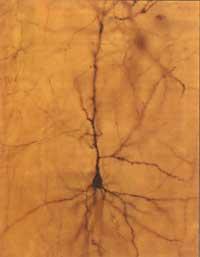Biology of Depression

Based on the treatment, cause and severity of the disease, within depression we can distinguish two large groups of diseases.
Psychiatrists have differentiated two broad types of patients in the area of depression. On the one hand, neurosis, which give excessive responses to the attacks of the medium, and on the other, those symptoms that are associated with a biochemical or genetic cause. The latter have an endogenous depression. However, it is very difficult to establish a limit between depressive neurosis and endogenous depression.
In endogenous depression, antidepressant drugs are used with good results. Depressive neurosis does not require antidepressant drugs and usually non-pharmacological or sedative treatments (e.g. psychotherapy) are used.
Numerous investigations
In the last thirty years, numerous studies have been conducted on what happens in biochemical or genetically endogenous depression. Among them, some measure the electrical record of our brain through evoked potentials and encephalograms, in which they have investigated mutually the discomfort (sleep discomfort) that occur during depression. Other research has measured the behavior of hormones in depression, discovering differences with normal people. Finally, other studies have been aimed at investigating the biology of neuron. Since neurone is the basis of brain functions, the brain needs relationships between neurons to perform their functions. The information is transported by electric impulses, but this electric drive must become a chemical impeller to move from one neuron to another. These chemical impulses occur in places called synapses.
Transmission of information
We know that “soma”, “axon” and “dentrita” form the neuron. The soma is the body of the neuron, which has its nucleus. The “axons” resemble long branches. After transporting the electric impulses from Axon to other neurons, the dentrites carry the information upwards so that the axone sends the information again.
The terminals located at the end of Axon are presynaptic terminals, along with which there are postsynaptic terminals. Between pre- and postsynaptic terminals, neurotransmitters provide information.
Being a chemical molecule, the neurotransmitter has special properties and functions, such as sending information from the presynaptic terminal to the postsynaptic. There are different neurotransmitters that perform different functions. Like noradrenaline, serotonin, acetylcholine, etc...
Membranous postsynaptics have special places to know these neurotransmitters. These places are proteins known as receptors, specific to neurotransmission.
Origin of endogenous depression
In the sixties, two biochemical hypotheses were formulated regarding neurotransmission to explain endogenous depression: noradrenergic depression and serotoninergic depression. Endogenous depressions are based on the reduction of neurotransmission. The Norwegian hypothesis is based on changes in noradrenaline and the serotonergic hypothesis on changes in serotonin.
In the studies carried out in the sixties in depressive patients, noradrenaline was measured. However, no changes were observed in the brain's encefardante fluid, or in the postmortem brain. It may be due to the techniques used. For a long time it was known that noradrenaline flows through a “pool” (reservoir) presynaptic terminal when the electric impulse arrives. Noradrenaline can be inactivated by metabolic enzymes (COMT, MAO), but normally 90% of noradrenaline is recirculated from synaptic space to the presynaptic terminal.
Normally, tricyclic antidepressants used against endogenous depression block this reabsorption, increasing the concentration of noradrenaline or serotonin of synaptic space and decreasing depression. Therefore, the key is in the noradrenaline or serotonin of sympathetic space. The norepinephrine of the presynaptic terminal is not so important, although the norepinephrine of all synapses is the majority.
Why is there little noradrenaline or serotonin in the synaptic space of patients suffering from endogenous depression?
The norepinephrine of the synaptic space controls its secretion through the mechanism of “feed-back”. Receptors described for the transmission in the postsynaptic and presinacetic membrane have been found. Its function would be the regulation of the release of neutrotransmitters.

When there are many norepinephrines in the synaptic space, the alpha-2 adrenoceptor of the presynaptic terminal detects it by inhibiting release. In this way, the concentration of noradrenaline in the synaptic space suffers a remarkable decrease.
Latest investigations
The trend of researchers in recent years has been aimed at clarifying the mechanism of receptors. Currently, the number of receptors and their intrinsic properties are being investigated.
These studies have shown that in patients with endogenous depression the number of receptors and their intrinsic properties are altered. The Alfa-2 adrenoceptor seems to be incorporated into these patients. If this were so, it could be expected that the alpha-2 adrenoceptor would increase the inhibition of noradrenaline release. Therefore, there would be less noradrenaline in the synaptic space.
People with endogenous depression often have depressive relatives. Therefore, it is observed that endogenous depression can present a genetic problem. In fact, the alpha-2 adrenoceptor is a protein that is encoded by DNA. The synthesis can present serious problems in the levels of transcription, coding, and regulation. In this way, the receptors undergo changes causing abnormalities that result in a malfunction of the neurotransmission. Therefore, there is still much to be investigated in the biochemistry of endogenous depression. In the coming years, treatment of endogenous depression and research in neurotransmission should be associated.
Advances in endogenous depression can be carried out through advantages in the mechanisms of receptors.
Below is the unanswered question to the biology of endogenous depression.
- Interactions between modified neurotransmission systems are not clear. How would these relationships be in endogenous depression?
- In depression, biological rhythms are produced, since the relationship between rhythm and changes in neurotransmission is not yet clear.
- What would be the biological indicators useful for differentiating endogenous depression from other depressions?






